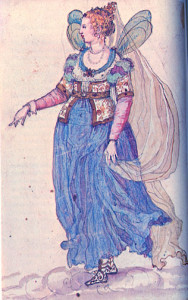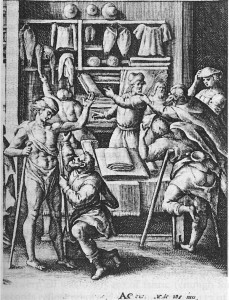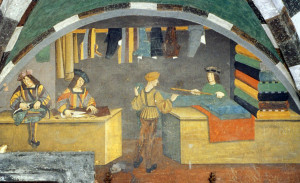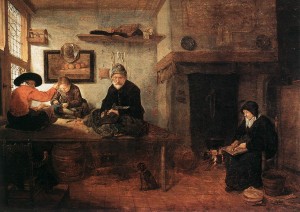A Tailor’s Wage
If I was a tailor in 16th century London, how many days’ or weeks’ worth of pay would three yards of kersey cost me?
It’s a difficult question to answer. For one thing, professional tailors usually received payment on a per-item basis, rather than receiving a “salary” or “wage” as we know it. For another, the sources I’ve found are usually specific to a particular time and place, and wages varied widely over the 16th and early 17th century.
I will be throwing shillings and pence about with abandon as I continue, so a quick refresher on English money in the 16th century: 12 pence equaled 1 shilling, and 20 shillings equaled £1.
One place where tailors were employed by the day, rather than by the piece, and employed for a number of years, was in the Royal Office of the Revels. A legion of tailors, painters, carpenters, leatherworkers and other artificers were needed to create the dazzling costumes and sets of revels and masques put on by Edward VI, Mary and Elizabeth. Although the number of revels staged decreased during Elizabeth’s reign, due to her preference for theatrical performance over the elaborate allegorical revels and masques preferred by her predecessors, tailors’ wages continued to be recorded through the end of the 1580s.
Feuillerat’s Documents Relating to the Office of the Revels in the time of Edward and Mary and Documents Relating to the Office of the Revels in the Time of Elizabeth, aka “The Loseley Mansuscripts”, describe a great deal about the revels and the clothing made for their participants. They also describe the tailor’s wages paid for the work. (1)

A fairy costume for a masque. Designed by Inigo Jones, 1611. Although this costume dates to several decades later than the revels of the 1560s and 70s, it was similar in style to those of earlier decades.
In 1548, 32 tailors were hired to work on costumes and stage properties for King Edward’s Shrovetide revels. The foreman was John Holt, yeoman; he received 9 pence a day for his pay. The other tailors all received 8 pence a day. They worked anywhere from 3 days and 2 nights to eight days and two nights, receiving an additional 8 pence for each night worked, as well as 8 pence for each day. One can imagine the frenetic activity of all of these men working late into the night, struggling to thread needles by candlelight, all to make the Shrovetide deadline.
In addition, as an officer, foreman John Holt was allowed “dieting charges” of two shillings a day. The other officers–master of the revels Sir Thomas Vaverden, the Clark comptroller John Bernard and the clerk, Thomas Phillips–were the only others who received this extra pay.
John Holt was also recompensed for charges out of his own pocket during the work. He hired a wagon and a barge on Shrovetide from Blakfriers to Greenwich to carry all of the masks and clothing to the location of the revels, and hired the same on Ash Wednesday to carry them back to Blackfriars. He also paid for 48 candles and candlesticks for them, needed for working by night, as well as for pack needles and thread. In all he laid out 28 shillings of his own money–a significant amount.
For the following Christmas revels of 1548, however, John Holt received only 8 pence a day–the same as the rest of the tailors. He still received his additional 2 shillings a day, and, as before, presented a bill for money he had laid out red and white wool, carriage of revels stuff to the site where the performance was held and back again, and for a considerable amount of thread.
He received 10 pence a day for the 1549 revels, while the other tailors received 7 pence; and, by 1550, he was listed as “John Holt, yeoman, Cutter at 2 shillings the day and 2 shillings the night”, with his dieting charges no longer mentioned. He continued to pay for all manner of things out of his own pocket during preparation of a revel: He paid to hire an Irish Bagpiper for one, and for making a dragon with seven heads for another.
The other tailors listed for 1550 made 8 pence a day and 8 pence a night, save for Thomas Clatterbook—such a fantastically Dickensian name!–who, as the Holt’s next in command, made 10 pence a day and 10 pence a night.
In records for 1557, in the time of Queen Mary, Holt was still making 2 shillings a day, while the other tailors received 12 pence a day. This held true through the end of her reign.
Further examination of the revels documents reveal that Holt, in addition to payment by the item, received “six pence sterling by the daye for the ouerseing and saufe keeping of the apparel and trappers of all and singular our maskes Revelles and disguysings.” Add to this the house granted him as yeoman, that he apparently leased out for additional income–”For the rente of his howse hired within the late blacke fryers from Thanunciatcion of our Lady 1557 untyll Thanunciacion of ur Lady nexte ensuinge 1558 by the space of one Hole yeare for 100 shillings.”—and he was quite well off.
John Holt’s right hand man, Thomas Clatterbook, worked his way up from the standard 12 pence a day to 20 pence a day by 1570. By this time Holt’s name wasn’t listed with tailors working by the day; Clatterbook was in charge of them. And that same rate, 20 pence for foreman Clatterbook and 12 pence a day for the remaining revels tailors, remained the same until the last warrant in Feuillerat, dated 1588.
The question remains: how representative of ordinary tailoring rates were these? It is a safe bet that the men hired by the royal court were at the top of their game; was a 12 pence a day wage usual for tailors lower down the tailoring ladder?
A statute of 1593 stated that “A master tailor that shall make gentlemen or gentlewomen their apparel, shall not take by the day above iiiid, and other common tailors, not above iid with meat and drink.” (2)
Another table of laborers’ and artificers’ wages from 1610 reflects the same amount: Tailors were to make 4 pence a day with meat and drink, and 8 pence a day without meat and drink. (3)
Clearly, working for the Queen had its advantages; the Revels tailors were making one and a half times the maximum amount specified for “master tailors” not recieving meat & drink as part of their wages.
What about young journeymen tailors, just starting out? On June 30, 1556, Bristol journeyman tailor Robert Malbe agreed to work for master tailor Nicholas Burchwood for 8 pence a week–the same amount that a revels tailor would make in a day!–though, in Robert’s case, he would be given food and drink for the week as well as a wage. (4)
Other 1556 Bristol contracts show a wide range of wages for young journeymen. Thomas a Pere received 10 pence a week with food and drink from master tailor Philip Braune. John Sharp contracted to work for 12 pence a week, and Anthony Sympson at 16 pence a week–the highest wage paid to a journeyman in Bristol in that year, the average being around 10 pence a week. Richard Prefleck agreed to work for William Rodgers for a whole year for 30 shillings. Fellow journeyman John Hall would receive 36 shillings 6 pence for a year’s service.
Newly freed apprentices, after serving the term of their apprenticeship, were frequently required to spend an additional (paid) year in service to their prior master at what, in comparison to the other wages we’ve seen, are quite minimal rates–even including the food and drink they were provided with.
In 1558, John Edwards was apprenticed to tailor Randolf Gomys for 8 years. Upon completion of this apprenticeship he was to receive “all tools of every kind for the said craft.” In addition he was to serve one year with Gomys after his apprenticeship ended, for which he would be paid 26s 8d in addition to meat and drink. (5)
Griffin Jones was apprenticed to Bristol tailor Thomas Davis in 1553 for 7 years, at the end to recieve 6s 8d. He was also to serve a year with Davis after he obtained his freedom, receiving 34s 4d as well as meat and drink.
These are young journeymen, just starting out; but some master tailors, those who were disabled or had difficulty finding work, also made very little. A census of the poor, made in Ipswich in 1598, sheds some light on the life of the “poor tailor” of Elizabethan times. (6)
One such was a man named Richard Mimpres. He was 35 and listed as “able”–that is, not injured or mentally “impotent”–but still made a weekly wage of only 21 pence. His wife picked wool for a living, and they had four children, ages 10, 7, 5 and 2; in the census, their needs were listed as “clothing” and “work.”
Another tailor, Henry Haule, was an older man of 60. His wife, also 60, was unable to work; he made a wage of 2 shillings a week, and received relief, in addition to this, of six pence per week from the Tooley charitable foundation in Ipswich.
Francis Goodking, 37, was another able tailor whose wife “helpeth him”. Together he made 3 shillings a week and she16 pence. They had two children, ages 7 and 5, and were listed as in need of firewood and of work, although they received no weekly relief.
There are later examples, from the early 17th century, showing how rates for tailor’s work increased over the 15 year span.
In 1628, in cambridge, a tailor worked for four days for 1 shilling a day. In 1630, there are records for a tailor working 12 days at 1 shilling 3 pence the day, and for 3 days at 1 shilling six pence the day. All three of these received meat and drink in addition to payment. (7)
It could be hard, making a living as a tailor. In Hull, the regulations of the Merchant Taylor’s guild were not kind to those struggling to make a living. A tailor was not allowed to set up a “board and trestles”, but must work out of an actual shop. Likewise, tailors in late 16th century Hull were not allowed to work at a customer’s home when making new garments, but only when repairing or mending them. (8)
Because of this, many tailors new to the guild who did not have the funds to set themselves up in a shop had no recourse but to become “botchers”, tailors that did repairs and alterations to garments. Without connections or the ability to obtain a loan, some of these people might never legally become full-fledged master tailors; and even those that were could be constrained in the work they were allowed to do. Records of the Bristol Merchant Taylor’s guild record how
“Matthew Dulle hath byn proved a fore the master and all his bretherene, and by favor of the master and hys bretherene they have allowyd hym suche garments makyng as here after forthwyth: in primis, a cote, a doblet, a woman’s gowne, a kyrtyll, a Spanyshe eloke, a jackett.” (9)
 As an alternative to daily or weekly wages was the more common payment-by-the-item income that master tailors, and tailors owning their own shops, depended upon. Managing payment could be a bit complex; there are several cases of tailors’ bills being presented to clients quarterly, or even twice a year, which must have made managing cash flow a bit tedious in-between payments. Even once a bill was presented, they were frequently paid piecemeal. Some bills waited years for payment; The following note on a bill for clothing made for Amy Dudley, the wife of the Earl of Leicester, is one such example. The clothing was made in 1560; the bill itself wasn’t paid until 1566. The somewhat exasperated tone of the addendum accompanying payment is revealing as well as entertaining:
As an alternative to daily or weekly wages was the more common payment-by-the-item income that master tailors, and tailors owning their own shops, depended upon. Managing payment could be a bit complex; there are several cases of tailors’ bills being presented to clients quarterly, or even twice a year, which must have made managing cash flow a bit tedious in-between payments. Even once a bill was presented, they were frequently paid piecemeal. Some bills waited years for payment; The following note on a bill for clothing made for Amy Dudley, the wife of the Earl of Leicester, is one such example. The clothing was made in 1560; the bill itself wasn’t paid until 1566. The somewhat exasperated tone of the addendum accompanying payment is revealing as well as entertaining:
“In consideration of his long forbearing of his money, there is nothing abated of his Byll. Which said some of thirteen poundes ten shillings and sevenpence remayne due to the said William Edney by the right honerable Th’ Erle of Lecester, for all manner of mourninge and other demands, From the beginning of the world till this xxvth of Februarie, Anno Octavo Elizabeth Regine.” (10)
Some tailors, in addition to fees charged for making garments, obtained extra money on the side in a number of underhanded ways. The Defence of Conny-Catching, written in 1592, describes how a particular tailor did just this:
In Yorkshire there dwelt a woman’s tailor famous for his art but noted for his filching, which although he was light-fingered, yet for the excellency of his workmanship he was much sought to, and kept more journeymen than any five in that city did, and albeit he would have his share of velvet, satin, or cloth of gold, yet they must find no fault with him lest he half spoiled their garment in the making…all the gentlewomen of the country cried out upon him, yet could they not part from him because he so quaintly fitted their humours; at last it so fell out that a gentlewoman not far from Ferrybridge(?) had a taffeta gown to make, and he would have no less at those days than eleven ells of ell-broad taffeta, so she bought so much, and ready to send it, she said to her husband in hearing of all her serving-men: What a spite is this, seeing that I must send always to yonder knave tailor two yards more than is necessary, but how can we amend us? All the rest are but botchers in respect of him.
The author of the Conny-Catcher also berated tailors for introducing new fashions so frequently that gentlemen and ladies had no idea how much these novel garments cost, and were willing to hand over as much fabric as the tailor demanded, never realizing that a quarter of the fabric had gone into his pockets.
what poet hath so many fictions, what painter so many fancies, as a tailor hath fashions to show the variety of his art, changing every week the shape of his apparel into new forms, or else he is counted a mere botcher? The Venetian and the galligaskin is stale, and trunk-slop out of use; the round hose bombasted close to the breech, and ruffed about the neck with a curl is now common to every cullion in the country, & doublets, be they never so quaintly quilted, yet forsooth the swain at plough must have his belly as side as the courtier, that he may piss out at a button-hole at the least.
And all these strange devices doth the tailor invent to make poor gentlemen conies, for if they were tied to one fashion, then still might they know how much velvet to send to the tailor, and then would his filching abate. But to prevent them, if he have a French belly, he will have a Spanish skirt, and an Italian wing seamed and quartered at the elbows… Thus will the fantastic tailor…ever ask more velvet by a yard and a half than the doublet in conscience requires.
To give some idea of how fees for garments made compare to fees-by-the-day, I have collected references to costs for making garments in the cases where they were separated from materials costs, from tailor’s bills throughout the 16th to early 17th centuries. The sources for the below excerpts are found at DressDB: Tailor’s Bills and Receipts and DressDB: Books of Account.
In a perfect world, if a petticoat cost 8 pence to make, and tailors wages for that same year averaged 4 pence a day, we could tentatively state that a petticoat took around 2 days to make. Unfortunately, the variation in charges for making the same type of garment–even made by the same person, in the same year–is such that this is impossible. Some petticoats might be interlined, some hose might have welts or guards applied, some gowns might require more pad-stitching and construction than others. A poor woman’s petticoat of russet could cost 8 pence; a velvet guarded petticoat, interlined, lined, bordered and guarded and stitched with lace trim, could cost 106 pence in making costs alone for the same year. This variation is strikingly evident in the charges listed below.
The original accounts listed charges in shillings and pence. To aid in comparison across garments, I have converted all prices to pence only.
1530
making a kirtle of red saye 24 pence
making a kirtle 10 pence
making a gown 12 pence
making a gown 12 pence
making a partlet of velvet 6 pence
1558
making a worsted gown 80 pence
making a damask gown 80 pence
1559
making a pair of shoes 24 pence
making a kirtle of white satin 24 pence
making a bodice & sleeves for a gown of satin 24 pence
making a gown of worsted 96 pence
making a waistcoat 12 pence
making white satin sleeves cut & stiched 30 pence
1566
making a round kirtle: 48 pence
making a round kirtle cut all over fringed: 24 pence
making a round kirtle with fringe: 36 pence
making a peticoat with a velvet guard stitched with 8 stitches 48 pence
making a peticoat with bodice 120 pence
making a mantle of cloth: 80 pence
making a pair of white satin sleeves: 30 pence
making a spanish gown of velvet, with a fringe 106 pence
1581
making 2 gowns and a petticoat 14 pence
1588
making hose 12 pence
making a striped canvas doublet 36 pence
making a pair of hose 40 pence
1589
making a pair of fustian hose 36 pence
1590
lining and making a kirtle 24 pence
making a kirtle and bodies 60 pence
making a black velvet gown 120 pence
making a gown gathered in the bodies 106 pence
making a gown of serge 72 pence
making a black cloth gown 96 pence
making a grograin gown & stomacher 106 pence
making a gown of violet broadcloth 75 pence
making a strait bodied gown 24 pence
making a pair of bodies 36 pence
making bodies and sleeves 40 pence
making an overbody/mending a petticoat, 4 pence
making a taffeta doublet 106 pence
making a doublet: 48 pence
making hose and doublet: 54 pence
making a pair of round hose 40 pence
making a pair of hose, a jerkin & two doublets 32 pence
1591
making a kirtle 24 pence
making a kirtle 18 pence
making a pair of french bodies 24 pence
making a pair of french bodies 20 pence
making a ruff 18 pence
making a petticoat 42 pence
making a petticoat & bodies 36 pence
making a petticoat 10 pence
making a guarded petticoat 40 pence
making a gown 84 pence
making a gown 81 pence
making a gown 72 pence
making a gown 108 pence
making a gown 54 pence
making a gown 84 pence
making a gown 48 pence
1592
making a petticoat and waistcoat 16 pence
making a petticoat 48 pence
making a waistcoat 71 pence
making a cloak 30 pence
making a cloak 32 pence
making a frieze jerkin 16 pence
making a velvet jerkin 30 pence
making a frieze jerkin 12 pence
making a mornyng gown and hood 40 pence
making a cloak 40 pence
1593
making a jerkin and hose of green kersey laced with black & gold 79 pence
making a waistcoat of white bays 12 pence
making a frieze jerkin 24 pence
making velvet venetians 24 pence
making hose 40 pence
1594
making a gown of parti-color cloth 40 pence
making a gown of london russet laced and lined 8 pence
makinga a gon with whalebone sleeves: 72 pence
making a pair of bodies to a petticoat: 4 pence
making a doublet of white satin 48 pence
1595
making a cloak of silk grograin laced with 2 laces, lined with taffeta 80 pence
making a doublet of black satin 48 pence
making a doublet of russet saten 48 pence
making a jerkin of velvet laced and striped 80 pence
making velvet hose 48 pence
1597
making a coif 1 pence
making a poor woman’s petticoat 6 pence
making a poor woman’s petticoat, lined: 8 pence
making a frock for a poor woman, upper bodies lined, 8 pence
making poor man’s breeches and jerken 12 pence
making a poor man’s long coat 8 pence
making a poor woman’s waistcoat 4 pence
making 5 pair of poor men’s hose 49 pence
1601
making three kersey gowns: 20s (6.6s each)
making two peticoats of striped silk mockado with a binding lace 72 pence
making a straight-bodied satin gown 96 pence
1604
making a doublet 72 pence
making hose 60 pence
making a petticoat 10 pence
making a petticoat 60 pence
making bodies 3 pence
making a gown 84 pence
making a gown 156 pence
making a gown, bodies & kirtle 120 pence
Footnotes
1. Feuillerat, A. Documents relating to the Revels at Court in the time of King Edward VI. and Queen Mary-the Loseley Manuscripts. . 1914. also, Feuillerat, A. Documents relating to the Revels at Court in the time of Queen Elizabeth . (Back)
2. James, Edwin. A History of Agriculture and Prices in England: 1583-1702 pg 214 (Back)
3. The rates of wages of servants, labourers and artificers, set down and assessed at Oakham, within the county of Rutland, by the justices of peace there, the 28 day of April, AD 1610″. in Archaeologia vol. 11, p. 200. Other rates reflected a similar proportion of with/without meat and drink: Carpenters got 5d a day with meat and 10 without. (Back)
4. Fox, Francis Frederick. Some account of the Ancient fraternity of merchant taylors of Bristol (Back)
5. Ralph, Elizabeth. Calendar of the Bristol Apprentice Book 1532-1565. Part III 1552-1565 (Back)
6. Webb, J. Poor Relief in Elizabethan Ipswitch (Back)
7. James, Edwin. A History of Agriculture and Prices in England: 1583-1702 pg 637 (Back)
8. Lambert, Joseph. Two Thousand Years of Gild Life, pg 238-244. (Back)



Leave a Reply